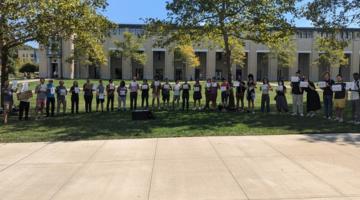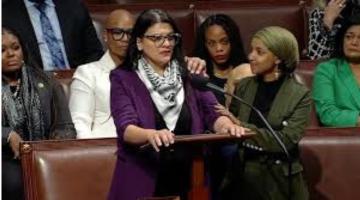Ideological exclusion and deportation from the United States, and how they has been consistently used as tools of political repression.
“There was never a period of open immigration.”
In this series, we ask acclaimed authors to answer five questions about their book. This week’s featured author is Julia Rose Kraut.Kraut, a lawyer and historian, writes about immigration and First Amendment law and history. She was the inaugural Judith S. Kaye Fellow for the Historical Society of the New York Courts and an Andrew W. Mellon Foundation Fellow at the New-York Historical Society. Her book is Threat of Dissent: A History of Ideological Exclusion and Deportation in the United States.
Roberto Sirvent: How can your book help BAR readers understand the current political and social climate?
Julia Rose Kraut: Threat of Dissent is a political, social, and legal history of exclusion and deportation from the United States based on one’s political beliefs, expressions, and associations. I argue that ideological exclusions and deportations are tools of political repression used to suppress the threat of dissent, including calls for revolution or reform, challenges to capitalism or the status quo, and criticism of US politicians or policies. They reflect a fear of subversion, as well as a fear of foreigners perceived as the source of subversion. The book’s narrative traces a long history of ideological restrictions in the United States from the Alien Friends Act of 1798 to the War on Terror and the Trump administration. It seeks to provide a window into past and present questions of national security, dissent and censorship, foreign policy and relations, xenophobia and nativism, and free expression and association.
Ideological exclusions and deportations are pertinent to the present, and not relics of the past. Public officials have exploited the vulnerability of foreign-born immigrants and visitors and have barred and expelled them from the United States because of their associations, as well as what they have wrote and said. During the War on Terror, ideological exclusions have continued through the use of guilt by association in the name of national security, as well as through public officials’ abuse of discretion to deny visas and exclude at the border, and to selectively deport as a form of retaliation against those critical of the United States. Inspections of phones and laptops and requirements to disclose social media handles to enter the United States reveal that while technology has changed, exclusion based on one’s beliefs, expressions, and associations remains.
What do you hope activists and community organizers will take away from reading your book?
After reading Threat of Dissent, I hope activists and community organizers understand the underpinnings and underlying dynamics behind ideological exclusions and deportations from the United States, and how they have been consistently used as tools of political repression. I also hope activists and organizers will be able to see themselves within this narrative and in the various organizations and individuals who challenged ideological restrictions and the suppression of expression.
The story of ideological exclusion and deportation is interwoven through the story of immigration and civil liberties activism and advocacy in the United States. The book describes the creation of the first free speech organization, the Free Speech League, in 1902, and its challenge to the first ideological exclusion case. Ideological deportations played an important role in the founding of the American Civil Liberties Union (ACLU) in 1920, and would lead to the creation of the American Committee for Protection of Foreign Born (ACPFB) in 1933. The ACLU has also challenged ideological exclusions, as have PEN America, the Brennan Center for Justice, and the Knight First Amendment Institute.
Threat of Dissent highlights the advocates and attorneys in these organizations who represented those barred or expelled and who drew public attention to their constitutional challenges and to their clients through petitions and mass protests, pamphlets and press releases, and campaigns and direct appeals to public officials. The book examines their strategies and obstacles—how they tried to prevent deportations and exclusions while attempting to change the law. It also includes their main argument that ideological restrictions were a form of censorship, which depicted the United States as a fearful, insecure nation, and undermined its image and self-identity as a nation of immigrants, serving as a beacon of freedom and refuge from oppression.
We know readers will learn a lot from your book, but what do you hope readers will un-learn? In other words, is there a particular ideology you’re hoping to dismantle?
The history of ideological exclusion and deportation in the United States has often fallen through the cracks of immigration and First Amendment scholarship, or appeared only in discussions of World War I and the Red Scare or as part of examinations of McCarthyism during the Cold War. I would like readers of Threat of Dissent to un-learn this omission and limited perception of ideological exclusion and deportation, and instead learn about the long history of ideological restrictions and how it fits within and runs through both First Amendment and immigration law and history.
I also join other immigration historians in trying to dismantle the myth of open, unregulated immigration in the United States, particularly in the 19th century. There was never a period of open immigration. While the US Constitution stated that Congress held the power to regulate naturalization, it did not explicitly address regulation of immigration. Thus, it was left to the states to restrict immigration, which they did until the late 19th century. In Threat of Dissent, I discuss this restriction under the states’ police power, the shift to federal regulation, and the Supreme Court’s establishment of the plenary power doctrine—requiring judicial deference to Congress, which holds the power to restrict immigration as an expression of national sovereignty and inherent in a nation’s right to self-preservation, and deference to federal officials who enforce and implement these restrictions. I argue that the majority of the Supreme Court has helped to perpetuate the use of ideological restrictions as tools of political repression, because it has interpreted these restrictions as an immigration issue, and not as a First Amendment issue. This interpretation has led the Court to apply the plenary power doctrine, which has insulated ideological restrictions from substantive judicial review and scrutiny under First Amendment protections and precedent.
Who are the intellectual heroes that inspire your work?
There are so many historians, lawyers, and activists who have inspired me, and I include them in the Acknowledgments section in Threat of Dissent. While writing this book, I found that I was most inspired by those radicals, labor organizers, artists, writers, scientists, and scholars who faced ideological exclusion or deportation, including Emma Goldman, John Turner, Graham Greene, Charlie Chaplin, Harry Bridges, Carlos Fuentes, Gabriel García Márquez, Ernest Mandel, Tariq Ali, and Shirley Graham Du Bois. I also drew inspiration from the public officials who tried to end ideological exclusion like Congressman Barney Frank (D-MA) or who used their interpretive, prosecutorial, or ultimate discretion to prevent ideological exclusions and deportations, like Assistant Secretary of Labor Louis F. Post and Secretary of Labor Frances Perkins.
My intellectual heroes and heroines are the lawyers who represented those facing exclusion and deportation and worked for organizations such as the Free Speech League, the American Civil Liberties Union (ACLU), the American Committee for Protection of Foreign Born (ACPFB), and the National Emergency Civil Liberties Committee (NECLC). Lawyers like Clarence Darrow and Leonard Boudin used strategies to create and circumvent legal precedent to support their arguments challenging ideological exclusions and deportations as a form of censorship, which chilled free expression and association and violated the First Amendment. Carol Weiss King served as the General Counsel for the ACPFB and was considered the greatest immigration attorney in the United States during the 1930s and 1940s. She brought the most important cases and challenges to detention, denaturalization, and ideological deportation, including preventing the deportation of labor organizer Harry Bridges. King was fearless, determined, and brilliant, her arguments were forceful, strategic, and pragmatic, and she mentored and encouraged other female attorneys.
In what way does your book help us imagine new worlds?
Threat of Dissent traces ideological exclusion and deportation in the United States, revealing a remarkable consistency and continuity over time. One learns from the past in order to better understand the present and to shape the future. If this book helps to imagine new worlds, it does so by examining the passage, enforcement, and challenge to ideological restrictions and identifying why the use of these restrictions to suppress dissent has persisted for so long and remains relevant.
At the end of the book, I conclude that the only way to prevent ideological exclusion and deportation is by Congress acting and passing federal legislation that provides legislative and judicial safeguards and oversight. I also discuss how the requirement to disclose social media handles to obtain a visa to enter the United States and inspections of phones and interrogations by federal officials at the border can lead and have led to ideological exclusions. Hopefully, after reading Threat of Dissent, readers will not just imagine, but also advocate for, a new world where Congress takes action and passes immigration reform legislation that prevents ideological restrictions and the abuse of technology and discretion to exclude or deport based on one’s political beliefs, associations, and expressions.
Roberto Sirvent is editor of the Black Agenda Report Book Forum.
COMMENTS?
Please join the conversation on Black Agenda Report's Facebook page at http://facebook.com/blackagendareport
Or, you can comment by emailing us at comments@blackagendareport.com















